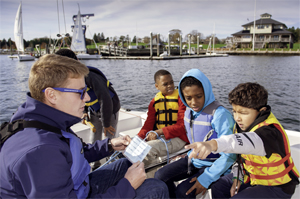Sailing and voyaging are an intriguing mix of companionship and solitude. And, given the need for people to stay separated to slow the growth of the COVID-19 outbreak, sailing groups and boatbuilders are looking for new ways to maintain the social nature of sailing and get prospective buyers to look at boats.
The group element of sailing is perfectly demonstrated by events like regattas and race series, where part of the fun is sailing together with your fellow crewmembers on your boat, as well as taking part in the captains’ meetings and cookouts and parties ashore. The gathering of fellow sailors, of people who all speak the same language of sailing, is the lifeblood of the social side of the sport.
The solitude aspect of sailing is something experienced by perhaps a smaller group of sailors who prefer the contemplative quiet of being aboard alone or with a small crew. In that realm, standing watch at midnight, for example, is a way to connect with the natural environment — and perhaps some of one’s own mental and spiritual environment — in a deep way that isn’t usually available on a boat full of outgoing conversationalists.
The social side of sailing requires a level of interaction only readily available in groups. Another element where groups work best is with sailing education. Community sailing organizations, of course, have education as a big part of their reason for being. Education is usually most efficient in groups and, for an activity like sailing, when people can learn “hands on.” The current situation is forcing some adaptation that may not be the best for hands-on learning but nevertheless continues the education for group members.
Orange Coast College in Costa Mesa, Calif., has long had a vibrant sailing program through its School of Sailing and Seamanship. It involves education and hands-on training from small boats up to offshore vessels. According to Mette Segerblom, the school’s sailing program coordinator, the need to go virtual has already involved changes at OCC. “We are looking at possibly moving our Coastal Navigation 1 class to an online environment and record an informational piece about USCG licensing,” Segerblom said. “However, we don’t have specific details as of yet. We are looking at all our classes for possible ways of engaging our students.”
Sailing Ships Maine, a sail-training nonprofit designed to educate young people about maritime careers, is partnering with AVTEC’s Alaska Maritime Training Center to offer maritime training to high school students interested in maritime learning. The “Introduction to Nautical Skills” course ran from Jan. 14 to March 31, with another offering of the course available in the fall.
 |
|
Some community sailing groups, like Sail Newport, are looking for new ways to replace hands-on sailing and sail training. |
|
Rodrigo Fernandez/Sail Newport, Sail Newport Pell School Sailing Program |
Sail Newport in Rhode Island got aboard the virtual boat early: The sailing organization joined up with the online virtual sailing site Sailonline.org and held a virtual race through Narragansett Bay dubbed the “Quahog Cup” on March 22. The racers sailed virtual Farr 30s. Sailonline is owned and operated by Sailonline NavSim AB, a not-for-profit, community-owned company. It defines its mission as “to offer a superior Internet-based sailing and navigation simulation to the global sailing community.” According to Sail Newport and Sailonline, this was the first in a series of planned virtual races.
When asked what prompted this idea, Brad Read, executive director of Sail Newport, wrote in an email: “This was something that we as a staff came up with. I knew some of the folks at Sailonline.org and they were wonderful in creating a course on their platform that I came up with — a tour of Narragansett Bay. [It was] really well received. The Sailonline community [was] super supportive. Happy to provide a distraction!”
Other efforts to go digital include yacht brokers like Denison Yachting in Florida, which is touting its “Virtual Boat Show.” Boatbuilders likewise have been making use of virtual tours to allow potential buyers the opportunity to “walk through” their boats. Hylas Sailing Yachts recently sent out a press release promoting its “Hylas H60 Virtual Guided Tour.” The company described the 360-degree presentation of its new H60 as a “powerful all-in-one 3D data platform that brings you to an accurate and immersive digital space.” Hylas isn’t the first boatbuilder to offer a user-controlled virtual tour of its boats, but it is another example of how this trend will likely expand to all builders.
With the challenges of COVID-19 likely to be around for some time, these types of virtual efforts will at least attempt to fill the gap left by the crimp in social sailing.

